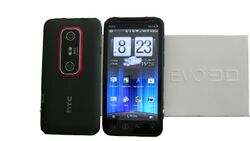Engineering:HTC Evo 3D
 | |
| Manufacturer | HTC Corporation |
|---|---|
| Series | HTC Evo |
| Compatible networks | Sprint, Virgin Mobile USA |
| Availability by region | June 24, 2011 (U.S.) |
| Predecessor | HTC Evo 4G |
| Successor | HTC Evo 4G LTE |
| Related | HTC Evo Shift 4G HTC Evo Design 4G |
| Type | Smartphone |
| Form factor | Slate |
| Dimensions | 127 mm (5.0 in) H 66 mm (2.6 in) W 12 mm (0.47 in) D |
| Mass | 170 g (6.0 oz) |
| Operating system | Official: Android 2.3.4 "Gingerbread" with HTC Sense 3.0 Current: Android 4.0.3 "Ice Cream Sandwich" with HTC Sense 3.6 Unofficial: Android 4.1.2 "Jelly Bean" via CyanogenMod 10 |
| CPU | Dual-Core, 1.2 GHz Qualcomm MSM8660 (Snapdragon) |
| GPU | Qualcomm Adreno 220 |
| Memory | 1 GB RAM |
| Storage | 4 GB eMMC |
| Removable storage | 8 GB microSDHC (32 GB max) |
| Battery | 1730 mAh Lithium-ion battery |
| Data inputs | Multi-touch touchscreen display 3-axis accelerometer 3-axis gyroscope Digital compass Proximity sensor Ambient light sensor |
| Display | 960×540 px, 4.3 in (10.9 cm) at 256 ppi qHD capacitive Super-LCD (0.49 megapixels) Autostereoscopic 3D-capable |
| Rear camera | Backside Illumination Dual 5-megapixel autofocus with dual LED flash, rear-facing |
| Front camera | 1.3-megapixel, front-facing |
| Connectivity | Tri-band CDMA/EVDO Rev. A (800/800ESMR[1]/1900 MHz) 2.5 to 2.7 GHz WiMAX 802.16e[2] Wi-Fi (802.11b/g/n)[3] Bluetooth v3.0 + HS Micro USB HDMI (via MHL) |
| Other | Wi-Fi Hotspot, FM-Radio, GPS navigation |
| Hearing aid compatibility | M4/T3[4] |
The HTC Evo 3D is a 3D-enabled Android smartphone developed by HTC, released exclusively in the United States through Sprint, and was re-released as a pre-paid smartphone by Virgin Mobile in May 2012 as the HTC Evo V 4G. A variation of Sprint's flagship HTC Evo 4G, the device is distinguished by its pair of 5 MP rear cameras, which made the Evo 3D the first cell phone to do so, which can be used to take photos or video in stereographic 3D, which can be viewed on its autostereoscopic display without the need for 3D glasses. Several GSM variants are also available in Canada, Europe and Asia.
History
Sprint announced the HTC EVO 3D during its CTIA in Orlando, Florida, in March 2011.
In June 2011,[5] Sprint officially announced that the HTC Evo 3D would be available on June 24, 2011.
On May 31, 2012, shortly after the release of its successor, the HTC Evo 4G LTE, Sprint's prepaid service Virgin Mobile re-released the Evo 3D as the Evo V 4G, as its first phone to use Sprint's WiMAX network. The Evo V 4G is identical to the Evo 3D, except that it ships with Android 4.0.3 and the Sense 3.6 interface instead of Sense 3.0 and Android 2.3. The new software also became available for the Evo 3D on Sprint as an update.[6]
Features
Processor
The Evo 3D utilizes a Snapdragon S3 chipset with a dual core 1.2 GHz processor
Screen
The Evo 3D uses a 960×540-pixel 4.3-inch screen coated with Gorilla Glass, capable of autostereoscopy for the viewing of 3D content without the need for specialized glasses.
Cameras
The Evo 3D uses two rear-facing 5-megapixel cameras, capable of capturing videos in 720p resolution in 3D or in 1080p while recording standard 2D. It can also take photos in stereographic 3D at 5 MPx2 resolution. It features a single 1.3-megapixel front-facing camera.
Software
The Evo 3D shipped with Android 2.3 and the HTC Sense 3.0 interface. An update was released to upgrade the phone to Android 4.0.3 with Sense 3.6; this update is pre-loaded on the Evo V 4G.
Storage
The Evo 3D features 4GB internal storage and a pre-installed 8 GB microSDHC card. Its microSD slot supports cards up to 32 GB. Unofficially, the Evo 3D also supports 64 GB microSDXC cards as long as they are reformatted as FAT32 file system format.
See also
- Android version history
- List of Android devices
- List of 3D-enabled mobile phones
References
- ↑ Zeman, Eric. "HTC Evo 3D Approved with 800MHz ESMR Support". Phonescoop.com. http://www.phonescoop.com/news/item.php?n=8261.
- ↑ "HTC Mobile Phones - Evo Sprint - Overview". Htc.com. http://www.htc.com/us/products/evo-sprint?view=1-1&sort=0#tech-specs.
- ↑ "HTC Evo 4G Update Back With Improved Wi-Fi". www.phonescoop.com. http://www.phonescoop.com/news/item.php?n=6236.
- ↑ "Sprint Relay Store". http://www.sprintrelaystore.com/.
- ↑ Savov, Vlad. "HTC Evo 3D Launches June 24th". Blog Post. https://www.engadget.com/2011/06/06/htc-evo-3d-launches-on-june-24th-for-200-joined-by-evo-view-4g/.
- ↑ "HTC EVO V 4G (Virgin Mobile USA) hands-on". Engadget. https://www.engadget.com/2012/05/08/evo-v-4g-hands-on/.
External links
 |

